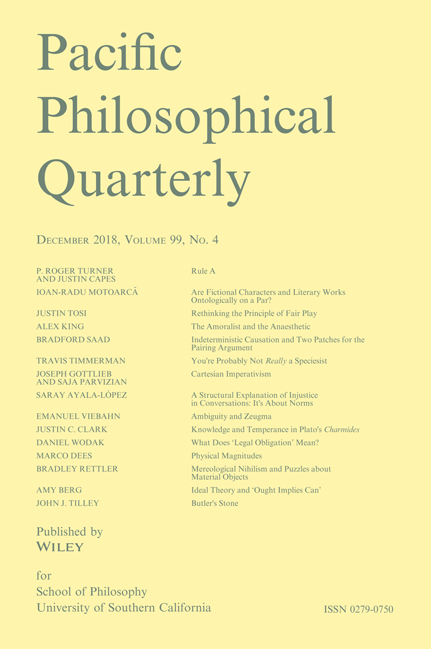Original Article
Cartesian Imperativism
Joseph Gottlieb, Saja Parvizian,
Saja Parvizian
Philosophy Department, University of Illinois at Chicago
Search for more papers by this authorJoseph Gottlieb, Saja Parvizian,
Saja Parvizian
Philosophy Department, University of Illinois at Chicago
Search for more papers by this authorAbstract
We propose a novel reading of Descartes' views on the nature of pain, thirst, and hunger: imperativism. According to imperativism, rather than (exclusively) having intentional contents individuated by a set of correctness conditions specifying the way the world is, pain thirst, and hunger have contents individuated by satisfaction conditions, which specify the way the world ought to be. Unlike representationalist treatments, the imperativist reading satisfies the unique health-preserving role Descartes sets out for pain, thirst, and hunger, without inflating his austere metaphysics of res extensa.
References
- Alanen, L. (1994). ‘ Sensory Ideas, Objective Reality, and Material Falsity,’ in J. Cottingham (ed.) Reason, Will, and Sensation: Studies in Descartes's Metaphysics. New York: Clarendon Press, pp. 229–250.
- Boghossian, P. and Velleman, D. (1989). ‘Color as a Secondary Quality,’ Mind 98(January), pp. 81–103.
10.1093/mind/XCVIII.389.81 Google Scholar
- Bourget, D. (2010). ‘Consciousness is Underived Intentionality,’ Noûs 44(1), pp. 32–58.
- Byrne, A. (2001). ‘Intentionalism Defended,’ Philosophical Review 110(2), pp. 199–240.
- Crane, T. (2009). ‘Is Perception a Propositional Attitude?’ The Philosophical Quarterly 59(236), pp. 452–469.
- Cunning, D. (2006). ‘ Descartes on Sensations and Ideas of Sensations,’ in P. Hanna, A. McEvoy and P. Voutsina (eds) An Anthology of Philosophical Studies. Athens: Atiner Publishing, pp. 17–32.
- De Rosa, R. (2007a). ‘The Myth of Cartesian Qualia,’ Pacific Philosophical Quarterly 88(2), pp. 181–207.
- De Rosa, R. (2007b). ‘A Teleological Account of Cartesian Sensations?’ Synthese 156(2), pp. 311–336.
- De Rosa, R. (2010). Descartes and the Puzzle of Sensory Representation. Oxford: Oxford University Press.
10.1093/acprof:oso/9780199570379.001.0001 Google Scholar
- Descartes, R. (1897). in C. Adam and P. Tannery (eds) Oeuvres de Descartes, 12 vols. Paris: L. Cerf ‘AT’ in text.
- Descartes, R. (1985). The Philosophical Writings of Descartes, 2 Vols., J. Cottingham, R. Stoothoff and D. Murdoch, trans. London: Routledge. ‘CSM’ in text.
- Field, R. (1993). ‘Descartes on the Material Falsity of Ideas,’ The Philosophical Review 102, pp. 309–333.
- Hall, R. (2008). ‘If It Itches, Scratch!’ Australasian Journal of Philosophy 86(4), pp. 525–535.
- Hanks, P. (2007). ‘The Content–Force Distinction,’ Philosophical Studies 134, pp. 141–164.
- Hatfield, G. (2013). ‘ Descartes on Sensory Representation, Objective Reality, and Material Falsity,’ in K. Detlefsen (ed.) Descartes' Meditations: A Critical Guide. Cambridge: Cambridge University Press, pp. 127–150.
10.1017/CBO9781139030731.012 Google Scholar
- Klein, C. (2007). ‘An Imperative Theory of Pain,’ Journal of Philosophy 104(10), pp. 517–532.
- Klein, C. (2012). ‘Imperatives, Phantom Limb, and Hallucination by Presupposition,’ Philosophical Psychology 25(6), pp. 917–928.
- Klein, C. (2015). What the Body Commands: An Imperative Theory of Pain. Cambridge, MA: MIT Press.
- Klein, C. and Martinez, M. (2016). ‘Pain Signals are Predominantly Imperative,’ Biology and Philosophy 31(2), pp. 283–298.
- MacKenzie, A. (1990). ‘Descartes on Sensory Representation,’ Canadian Journal of Philosophy 20(Supplement), pp. 109–147.
10.1080/00455091.1990.10717224 Google Scholar
- Martin, M. G. F. (2002). ‘The Transparency of Experience,’ Mind & Language 4(4), pp. 376–425.
- Martinez, M. (2011). ‘Imperative Content and the Painfulness of Pain,’ Phenomenology and the Cognitive Sciences 10(1), pp. 67–90.
- Martinez, M. (2015). ‘Pains as Reasons,’ Philosophical Studies 172(9), pp. 2261–2274.
- Nanay, B. (2012). ‘Action-Oriented Perception,’ European Journal of Philosophy 20(3), pp. 430–446.
- Nelson, A. (1996). ‘ The Falsity in Sensory Ideas: Descartes and Arnauld,’ in E. Kremer (ed.) Interpreting Arnauld. Toronto: University of Toronto Press.
- Nelson, A. (1997). ‘Descartes's Ontology of Thought,’ Topoi 16(2), pp. 163–178.
- Parsons, J. (2013). ‘Command and Consequence,’ Philosophical Studies 164(1), pp. 61–92.
- Robinson, W. (1998). ‘Intrinsic Qualities of Experience: Surviving Harman's Critique,’ Erkenntis 47, pp. 285–309.
10.1023/A:1005339601814 Google Scholar
- Searle, J. (1983). Intentionality. Oxford: Oxford University Press.
10.1017/CBO9781139173452 Google Scholar
- Schmitter, A. (2008). ‘ How to Engineer a Human Being: Passions and Functional Explanation in Descartes,’ in J. Broughton and J. Carriero (eds) A Companion to Descartes. Oxford: Blackwell, pp. 426–444.
10.1002/9780470696439.ch25 Google Scholar
- Shoemaker, S. (1994). ‘Phenomenal Character,’ Noûs 28(1), pp. 21–38.
- Simmons, A. (1999). ‘Are Cartesian Sensations Representational?’ Noûs 33(3), pp. 347–369.
- Simmons, A. (2008). ‘ Guarding the Body: A Cartesian Phenomenology of Perception,’ in P. Hoffman and G. Yaffe (eds) Contemporary Perspectives on Early Modern Philosophy Essays in Honor of Vere Chappell. Peterborough, ON: Broadview Press, pp. 81–113.
- Skyrms, B. (2010). Signals: Evolution, Learning & Information. New York: Oxford University Press.
10.1093/acprof:oso/9780199580828.001.0001 Google Scholar
- Wright, W. (2003). ‘Projectivist Representationalism and Color,’ Philosophical Psychology 16(4), pp. 515–529.




